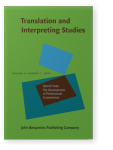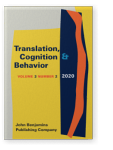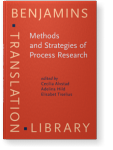Maureen Ehrensberger-Dow
List of John Benjamins publications for which Maureen Ehrensberger-Dow plays a role.
Journal
Exploring the Situational Interface of Translation and Cognition
Edited by Maureen Ehrensberger-Dow and Birgitta Englund Dimitrova
[Benjamins Current Topics, 101] 2018. v, 163 pp.
Subjects Cognition and language | Translation Studies
Cognitive space: Exploring the situational interface
Edited by Maureen Ehrensberger-Dow and Birgitta Englund Dimitrova
Special issue of Translation Spaces 5:1 (2016) v, 161 pp.
Subjects Communication Studies | Discourse studies | Translation Studies
Describing Cognitive Processes in Translation: Acts and events
Edited by Maureen Ehrensberger-Dow, Birgitta Englund Dimitrova, Séverine Hubscher-Davidson and Ulf Norberg
[Benjamins Current Topics, 77] 2015. v, 151 pp.
Subjects Cognition and language | Interpreting | Psycholinguistics | Translation Studies
Interdisciplinarity in Translation and Interpreting Process Research
Edited by Maureen Ehrensberger-Dow, Susanne Göpferich and Sharon O'Brien
[Benjamins Current Topics, 72] 2015. v, 159 pp.
Subjects Interpreting | Translation Studies
The Development of Professional Competence
Edited by Maureen Ehrensberger-Dow, Birgitta Englund Dimitrova and Séverine Hubscher-Davidson
Special issue of Translation and Interpreting Studies 9:1 (2014) vi, 177 pp.
Subjects Interpreting | Translation Studies
Describing Cognitive Processes in Translation: Acts and events
Edited by Maureen Ehrensberger-Dow, Birgitta Englund Dimitrova, Séverine Hubscher-Davidson and Ulf Norberg
Special issue of Translation and Interpreting Studies 8:2 (2013) vi, 153 pp.
Subjects Interpreting | Translation Studies
Interdisciplinarity in Translation and Interpreting Process Research
Edited by Maureen Ehrensberger-Dow, Susanne Göpferich and Sharon O'Brien
Special issue of Target 25:1 (2013) vii, 154 pp.
Subjects Translation Studies
2025 Chapter 2. Designing studies with naturalistic tasks Research Methods in Cognitive Translation and Interpreting Studies, Rojo López, Ana María and Ricardo Muñoz Martín (eds.), pp. 49–68 | Chapter
This chapter presents an overview of what constitutes a naturalistic task in cognitive translation and interpreting studies (CTIS), taking into account research settings, methodologies, data collection methods, and the participants involved. Naturalistic tasks are situated along a continuum that… read more
2021 Ergonomics and translation workplaces Handbook of Translation Studies: Volume 5, Gambier, Yves and Luc van Doorslaer (eds.), pp. 67–72 | Article
2020 Cognitive load in relation to non-standard language input: Insights from interpreting, translationand neuropsychology Translation, Cognition & Behavior 3:2, pp. 263–286 | Article
The linguistic, psycholinguistic, and neural processes underlying simultaneous interpreting and translation have attracted widespread interest in the research community. However, an understanding of the cognitive load associated with these bilingual activities is just starting to emerge, and the… read more
2020 MT Literacy—A cognitive view Translation, Cognition & Behavior 3:2, pp. 145–164 | Article
MT literacy means knowing how MT works, how the technology can be useful in a particular context, and what the implications are of using it for various purposes. As MT usage grows, the necessity for MT literacy also grows. This knowledge forms part of the greater need for digital literacies. In… read more
2019 Socio-technical issues in professional translation practice Translation Practice in the Field: Current research on socio-cognitive processes, Risku, Hanna, Regina Rogl and Jelena Milosevic (eds.), pp. 105–122 | Article
According to the International Ergonomics Association, a focus on organizationalergonomics recognizes that people work within socio-technical systems thatencompass tools, equipment, and computer interfaces as well as other actors intheir professional environment and networks. In recent research, we… read more
2018 Chapter 5.2. Process research A History of Modern Translation Knowledge: Sources, concepts, effects, D’hulst, Lieven and Yves Gambier (eds.), pp. 293–300 | Chapter
2018 Cognitive space: Exploring the situational interface Exploring the Situational Interface of Translation and Cognition, Ehrensberger-Dow, Maureen and Birgitta Englund Dimitrova (eds.), pp. 1–18 | Introduction
2017 Socio-technical issues in professional translation practice Translation Practice in the Field: Current research on socio-cognitive processes, Risku, Hanna, Regina Rogl and Jelena Milosevic (eds.), pp. 104–121 | Article
According to the International Ergonomics Association, a focus on organizational ergonomics recognizes that people work within socio-technical systems that encompass tools, equipment, and computer interfaces as well as other actors in their professional environment and networks. In recent… read more
2016 Investigating the ergonomics of a technologized translation workplace Reembedding Translation Process Research, Muñoz Martín, Ricardo (ed.), pp. 69–88 | Article
The modern translation workplace is characterized by intensive human-computer interaction and heavy use of language technology. In such settings, translators are subject to temporal and spatial constraints that can be mitigated or accentuated by good and poor ergonomic design, respectively. In the… read more
2016 Cognitive space: Exploring the situational interface Cognitive space: Exploring the situational interface, Ehrensberger-Dow, Maureen and Birgitta Englund Dimitrova (eds.), pp. 1–19 | Article
2015 Applying a newswriting research approach to translation Interdisciplinarity in Translation and Interpreting Process Research, Ehrensberger-Dow, Maureen, Susanne Göpferich and Sharon O'Brien (eds.), pp. 79–94 | Article
Translation is a situated activity that involves more than simply producing target texts from source texts. In order to understand what translators actually do when they translate, their psycho-biographies as well as the social setting of the workplace and the contextual resources must be… read more
2015 Ergonomics of the Translation Workplace: Potential for Cognitive Friction Translation as a cognitive activity, Alves, Fabio, Amparo Hurtado Albir and Isabel Lacruz (eds.), pp. 98–118 | Article
2014 Introduction to the special issue The Development of Professional Competence, Ehrensberger-Dow, Maureen, Birgitta Englund Dimitrova and Séverine Hubscher-Davidson (eds.), pp. 1–4 | Article
2013 Applying a newswriting research approach to translation Interdisciplinarity in Translation and Interpreting Process Research, Ehrensberger-Dow, Maureen, Susanne Göpferich and Sharon O'Brien (eds.), pp. 77–92 | Article
Translation is a situated activity that involves more than simply producing target texts from source texts. In order to understand what translators actually do when they translate, their psycho-biographies as well as the social setting of the workplace and the contextual resources must be… read more
2013 Describing cognitive processes in translation: Acts and events Describing Cognitive Processes in Translation: Acts and events, Ehrensberger-Dow, Maureen, Birgitta Englund Dimitrova, Séverine Hubscher-Davidson and Ulf Norberg (eds.), pp. 151–153 | Article
2013 Introduction Interdisciplinarity in Translation and Interpreting Process Research, Ehrensberger-Dow, Maureen, Susanne Göpferich and Sharon O'Brien (eds.), pp. 3–4 | Introduction
2011 Innovative subtitling: A reception study Methods and Strategies of Process Research: Integrative approaches in Translation Studies, Alvstad, Cecilia, Adelina Hild and Elisabet Tiselius (eds.), pp. 187–200 | Article
This paper presents the results of an experimental study investigating reception capacity and audience response to subtitled movies. Twenty-seven viewers were shown four movie excerpts, with commercially available standard subtitling or with innovative subtitling. The latter comprised additional… read more
















